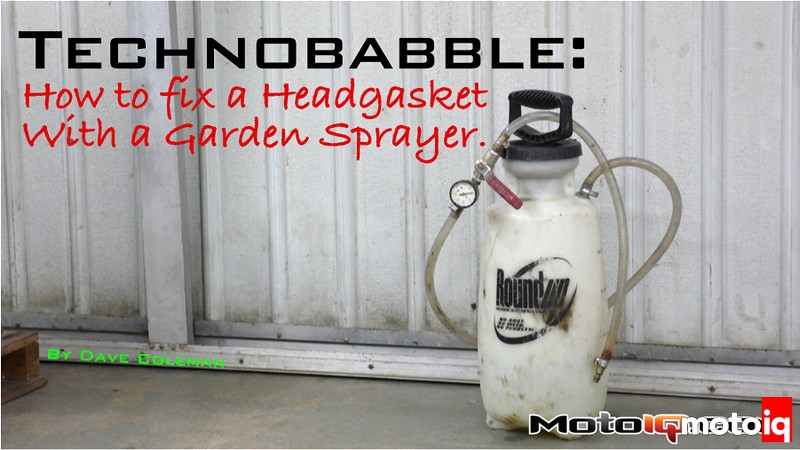
Technobabble: How to Fix a Head Gasket With a Garden Sprayer
It's not that I'm lazy, it's that I'm fiendishly clever. My SE-R Spec-V rally car started showing signs of a blown headgasket at the Gorman Ridge Rally in August, 2003, halfway through my desperate bid for the 2WD California Rally Championship. Most people trying to win not just one rally, but a whole series of them, would make some attempt at making this most basic of repairs.
But I'm not most people. In August, when the car first started mysteriously losing coolant and fouling spark plugs, I had a rally coming up. I only had two months, at that point to get it done. By the book hours most repair shops use to charge labor, 2 months is plenty of time. But if I changed the headgasket, I'd have to pull the cams to get to the head bolts, remove the front cover, pull the head, see what was warped and fix it, clean things off, and put everything back together in the right order. I'd have to actually get a service manual. And find my torque wrench. And clean my workbench.
On the other hand, I already had an old gallon jug I could fill with water and a bungee cord to hold it in the trunk, so why bother?
It helps to understand just what kind of blown headgasket I had at the time. It wasn't one of those coolant gushing out the tailpipe blown headgaskets. It wasn't a chocolate mousse in your oil pan or a Rorschach test in your radiator kind of blown headgasket. Instead the car ran fine almost all the time. Drive normally and nothing unusual would happen. Drive hard for a few miles and nothing at all would happen. Drive ridiculously, aggressively, destructively hard for 10 or 15 miles at a time, though, and it would still run fine. But as soon as you stopped driving hard it would run on three cylinders and sound like a really bad-ass Subaru. Sputter around like this for a minute or two and it would clear back up and be fine again. Oh, and then you'd run out of coolant and it would finally start getting a little warm. That's the kind of blown headgasket it was.
 |
|
The beauty of racing with a blown head gasket is that you can stop between stages, when the TV helicopter is circling and your competitors all watching, and make boiling coolant erupt from your radiator on cue. Then, after everyone is convinced you're about to retire, you can just add water, keep racing, and win a championship while nobody is looking.
|
So all it was doing was opening up under severe stress and steam cleaning one piston. It was like selective water injection. Once the engine cooled off, it would seal back up and you could re-fill the cooling system. Open the cap when it was hot, though, and it would boil all over the place. Park conspicuously in a line of rally cars waiting for a stage to start and you could wait until all your competitors were looking and the helicopter was circling before you started the car. When combustion pressure hit the cooling system, coolant would erupt from the cap, convincing everyone you were about to blow up. Then you could turn it off, top off the coolant, and go win a championship when nobody was looking.
With the championship out of the way, there were five whole months before the start of the next season and the Rim of the World ProRally, one of the hottest, roughest, most difficult rallies to finish with a blown headgasket. Perfect time to change it.
But then I got scared. What if it wasn't as simple as that? What if something was cracked? What if the head was warped? Or the block? What if the problem wasn't the headgasket itself, but the unsupported cylinder bores shifting around under the severe stress of rallying? Don't laugh, the same thing happened to Realtime Racing's World Challenge Spec-V's when they revved them to 7800 rpm. I'm only going to the stock redline, but what happened in a few hours on the track might happen in a few years in the dirt and probably means it will happen on street car after, oh, half a million miles or so.
Fearful of what I might find, I cleverly decided not to change the headgasket for Rim either. Instead, I decided to carry a garden sprayer with me.



1 comment
This is solid gold! We’ve been battling this issue for some time on our Honda Integra with no love seeing coolant temps north of 110 C causing the ECU to cut the power until the temps drop. We are halfway through the above recommendations with a custom cross-flow radiator and a radium coolant expansion tank to help with removing air pockets from the system. test day coming up shortly